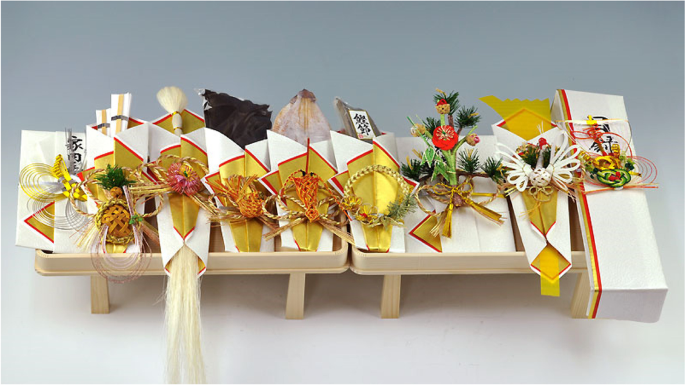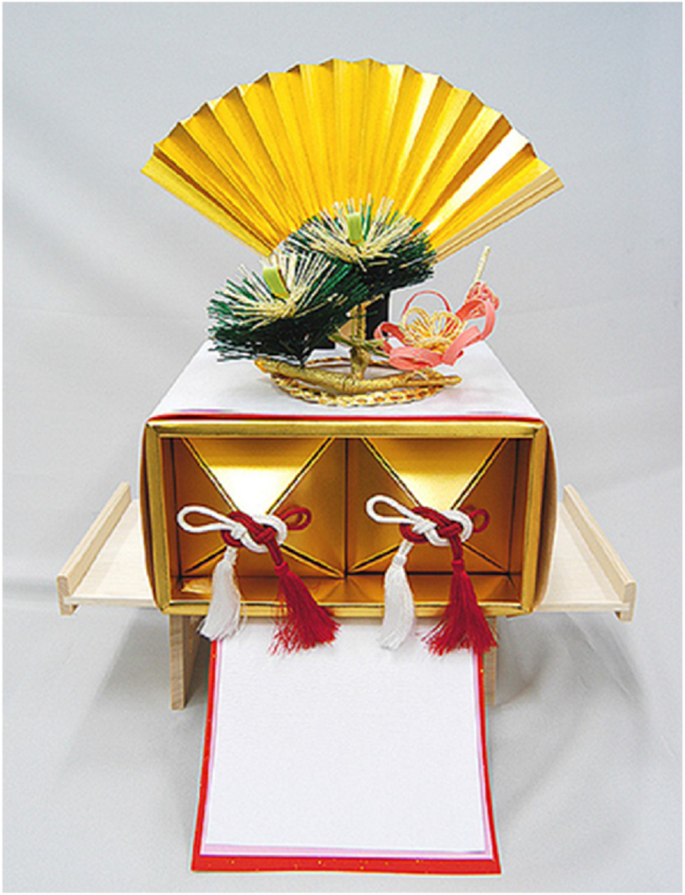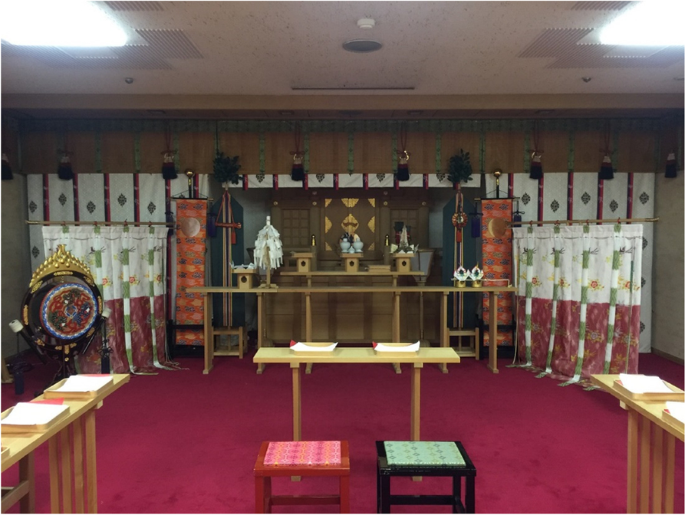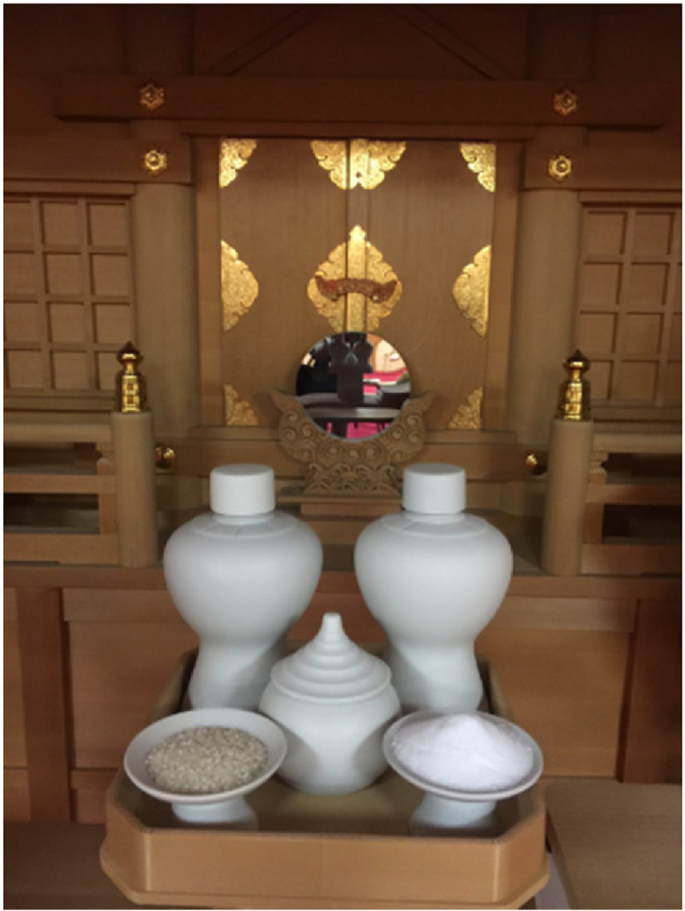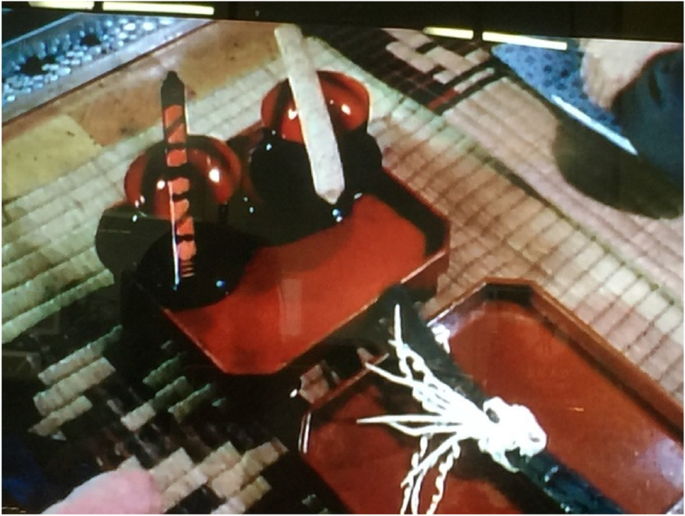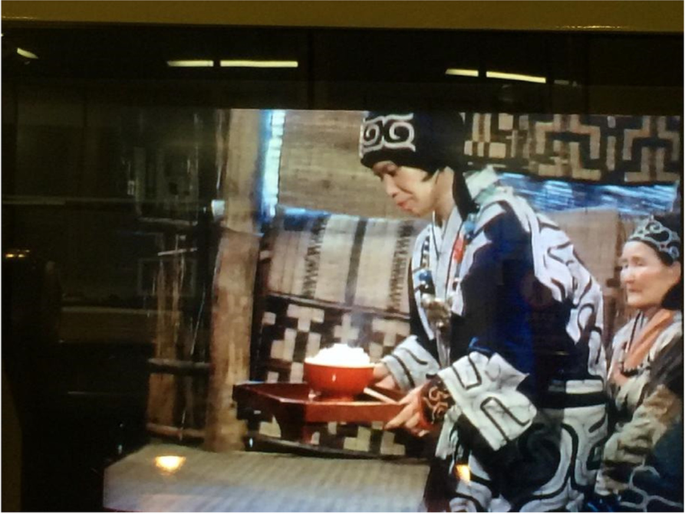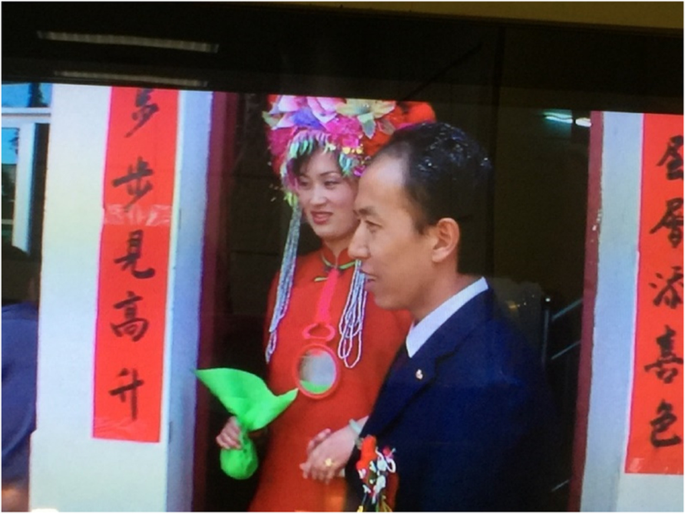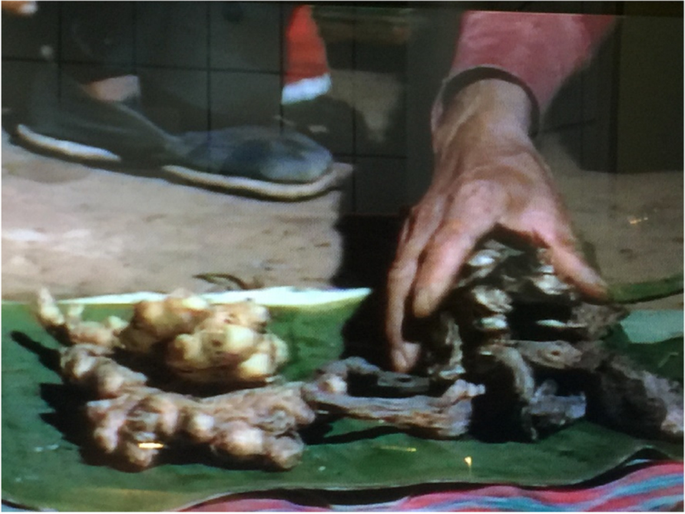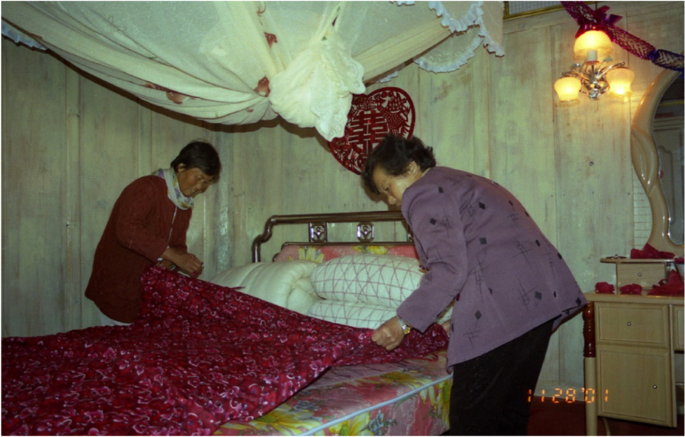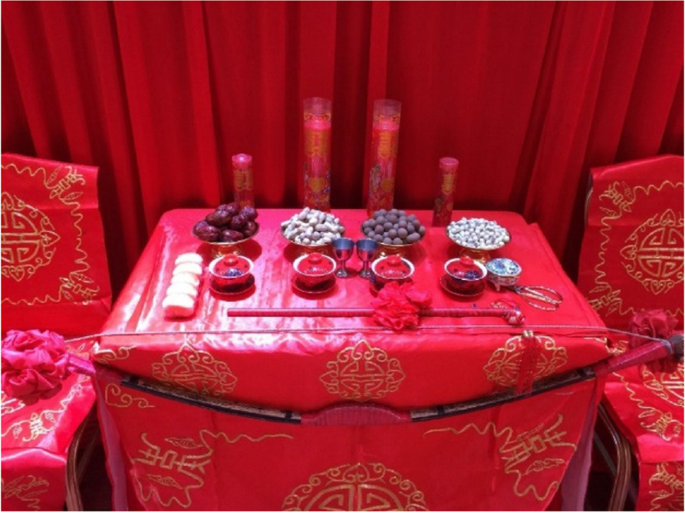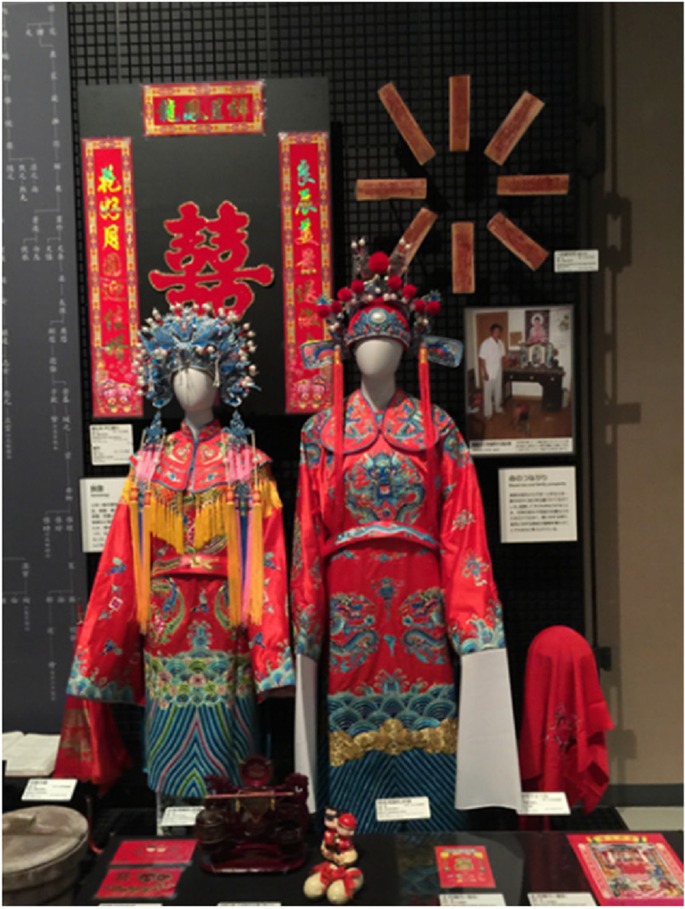- Original paper
- Open access
- Published:
The logic between nature and culture: food in the wedding traditions across East Asia
International Journal of Anthropology and Ethnology volume 7, Article number: 9 (2023)
Abstract
Based on the author’s fieldwork in China and Japan, literature research and the study of specimen materials and video data on weddings of ROK, Japan and China, which are collected by the Japan National Museum of Ethnology (or Minpaku), this paper attempts to explore the cultural symbolic significance that humans bestow on food, and to further reveal the cultural diversity in East Asia and the common structure of human mind by comparing the flow of food and the ways and scopes in which the wedding foods are consumed in East Asia.
In East Asia wedding customs, expectations through food for the bride’s fertility and her belonging to her husband’s patrilineal family are very common. However, the food and eating behaviors that express expectations for the groom are rare, only slightly visible in the dry bonito at the time of engagement in Japan and the 12 bowls of rice that the groom will eat on the day of the Yao wedding in China. Dried bonito signifies virility and victory of men, reflecting the features of Japanese maritime culture and the influence of samurai culture in history.
East Asian wedding rituals are diverse in form, but the commonality among them can also be seen, that is, human beings find cultural meanings in different natural environments that correspond to human society, and then internalize the natural attributes through homophonic pun, imitation and other ways. Food is used in weddings to express people’s best wishes for the happiness of the newlyweds’ families, to have descendants and longevity of their marriage.
Introduction
Weddings at all times and in all countries cannot do without food. So, what role does food really play in weddings? To understand the cultural logic of food in a wedding, one must first well understand the nature of weddings.
As one of the most important turning points in life, weddings have three main essential features.
First of all, wedding is a form through which a man and a woman become an official couple widely recognized by society. Secondly, marriage is not just a change in the relationship between the two individuals involved. The families, relatives, neighbors, and friends of both the groom and bride also develop new social relationships. In addition, marriage is also accompanied by the transfer of various rights and obligations, as well as the flow of property. Therefore, people hold solemn ceremonies to ensure that the couple and those closest to them can establish new social relations safely and smoothly. Thirdly, marriage also has economic significance (for example, negotiation and arrangement of betrothal gifts, dowry, cash gift and gifts). Arnold Van Gennep, a French ethnographer and folklorist, said in his most famous publication RITES DE PASSAGE (The Rites of Passage) that when a family or a village loses a competent laborer, whether male or female, it naturally requires some compensation. The groups to which man and woman belong have a stake in negotiations and economic arrangements (Gennep 1987).
In the paper, the author is to examine the functions that food assumes in the ritual passage to a marriage, specifically in the change of people’s social relations, on the basis of the three essential features of marriage mentioned above. Food is social in nature and it is the medium through which social relations are formed, changed, or terminated. The flow of food or the behavior of eating together constitutes a flowing space, while also carrying the transformation of the qualification of the relevant member and his/her relation with the community. In the wedding, food serves as the medium through which the roles of the bride and groom are transformed. Different types of food at different stages of the wedding can help the bride and groom complete the separation, transition, and transformation of their respective roles. Meanwhile, food can also help them establish and complete new kinships, nominal kinships, and geographical or divine relations.
Food is highly relevant to human family and even its origin. As early as 1961, Kyoto University anthropologist Imanishi Kinji published a paper titled “The Origin of Human Family” in the Studies in Ethnology (Imanishi 1961). He pointed out that the human family is a social unit where incest is avoided, and it is also established as a unit for food distribution. That is to say, sexual relations and food distribution constitute the basic functions of the family in early human family. Human ancestors learned to hunt and simultaneously began distributing food and co-eating based on food distribution. Hunting is usually a man thing which is common to all peoples of the world. When a man did not monopolize the prey he hunted, but instead distributed it to the particular women with whom he maintained a continuous sexual relationship and to the children he had with them, the human family began to take shape. Ishige Naomichi, a Japanese anthropologist and scholar of food culture, also once said that man is a kind of animal who “cooks” and “eats together”. “Human beings not only eat together with their own kind, but also with gods” (Ishege 1982).
The Western anthropologist Marcel Mauss also argued that the giving of gifts (including food) leads to marriages, and establishes kinships between relatives (Mauss 1962). Claude Levi-Strauss, a structuralist anthropologist, did a large number of research on myths and reduced their meanings to a basic set of binary opposing categories, namely “nature”-“culture”. This is indeed a relationship or corresponding situation that all human societies and cultures must deal with, because the cultural creation of all ethnic groups occurs in the practical process between “nature” and “culture”. Levi-Strauss pointed out that cooking “expresses very profoundly the bonds that connect all individuals to an environment, to a way of life and to a society” (Levi-Strauss 2007 [1971]). His analysis not only provides a convincing structuralism interpretation of the cooking practice of food culture of many ethnic groups and its manifestation in their respective myths, but also profoundly reveals the potential cognitive significance of food processing and classification from “raw” to “cooked”. According to structuralism, human beings become “civilized” through cooking and processing of food. Cooking, “lies between nature and culture”, “ensures the necessary combination of nature and culture. Cooking belongs to these two fields and reflects this duality in all its manifestations” (Levi-Strauss 2007 [1968]). In addition to working with tools and using symbols to express meanings, human beings also cook.
In light of the anthropologists’ discourses on food and food-processing mentioned above, we can see that the symbolic relationship between humans and food that moves from nature to culture is of universal significance.
Methods
The research methods adopted in the paper are mainly based on the author’s fieldwork in China (2001, 2017) and Japan (2017, 2018), literature research, and the investigation of specimen materials and video data on Korean, Japanese and Chinese weddings housed in the National Museum of Ethnology in Japan. Specifically, the information on Chinese Han weddings in this paper comes from the author’s fieldwork in Heshun Township, Tengchong County, Yunnan Province in 2001 and the author’s observation and recording of the wedding ceremony held in Liaoning Hotel, Heping District, Shenyang City in 2017. The research on the wedding traditions of Bai and Jingpo peoples in China is based on the author’s investigation of the specimen materials and ethnographic film collected in Minpaku. The research on the wedding food of the Yamato people in Japan is based on the fieldwork at the wedding venue of Hankyu Hotel in Toyonaka City, Osaka Prefecture, and relevant literature research conducted by the author in 2017 and 2018; the information on Ainu weddings in Japan is based on the author’s investigation of the ethnographic film in Minpaku, as well as the author’s interview with Associate Professor Saito Reiko, a scholar of Ainu. As for the symbolic meaning of food in Korean weddings, the research is mainly based on the author’s investigation of the ethnographic video materials in Minpaku, relevant literature and interviews.
Results and discussion
Food in Japanese weddings and relevant cultural evolution
There are records of marriage in ancient books such as Records of Ancient Matters (or Kojiki in Japanese) and Chronicles of Japan (or Nihon shoki in Japanese). Records of Ancient Matters is the earliest unofficial history style novel in Japan. A groom marrying into and living with his bride’s family was the basic form of marriage prevailing in ancient Japan. Such a tradition was in fact inherited mainly from the aristocratic society.
Along with the rise of the samurai class in the Kamakura period (1192–1333), the traditional mode of marriage featuring the groom marrying into the bride’s family began to give way to the new one which is characterized by the bride marrying into the groom’s family. It was during this period of time that various ceremonial forms of the samurai class, including wedding rituals, took shape and became the source of modern Japanese etiquette. “The remaining traditional Japanese wedding rules are derived from the samurai rituals compiled during the Muromachi period (1338–1573). The various ceremonial practices of the samurai class were passed down from the heads of the families of Ogasawara and Ise, who were responsible for etiquette of the samurai class, to the shogunate and superior samurai. In the late Edo period (1603–1867), daily rituals, including those for weddings and childbirth, were no longer confined to the samurai class but spread to the general society” (Fukushima Prefectural Museum 2005). After the Edo period, those wealthy merchants began to follow the wedding customs of the samurai class and began to hold exciting weddings.
Engagement (Yuino) gifts
In Japan, the engagement ceremony is called “yuino”, a term derived from The Book of Rites, a classical work of Confucianism from China, meaning that the groom-to-be presents betrothal gifts to the bride-to-be’s family. To seal the engagement, the two families hold a ceremony to exchange symbolic gifts with each other. In Japan, the term “wedding ceremony” began in the Edo period with the code of warrior households (Buke Shohatto), which was promulgated in 1615 as the legal basis for bakufu control of the daimyo and has been revised several times since then. The 5-, 7-, and 9-item betrothal gifts commonly seen today are derived from Buke Shohatto (Kanzaki 2008) (Fig. 1).
What is even more noteworthy is that food ingredients account for about half of engagement gifts nowadays. For example, dried abalone, dried inkfish, dried kelp, dried bonito, sake barrel made of willow wood, tea (Fig. 1). All of the food has symbolic meanings, representing the wish for the newlyweds to have a happy life, prosperity for their descendants and harmony between the families at both sides. Dried abalone is written as “noshi (のし, meaning ironFootnote 1)” as an engagement gift. Abalone has been considered a precious food and a gift of the highest order since ancient times. As an engagement gift, dried abalone represents the wish for longevity.
Dried inkfish is also one of the essential auspicious food ingredients for festive ceremonies since ancient times. As a betrothal gift, it is written in Chinese characters: 寿留女, representing the wish that the newlyweds have a lasting marriage just as the dried inkfish can be preserved for a long time. What’s more, for the dried inkfish, the longer you chew it, the more delicious it tastes. Therefore, the dried inkfish also implies the wish for a happy life.
Sake barrel made of Willow is also an engagement gift. In Japanese, it is called yanagidaru, and when it used as an engagement gift, it is written in five Chinese characters: 家内喜多留which literally mean lots of joys and happiness staying in the family. In the past, a barrel filled with one liter of sake was presented to the other family for the engagement. Nowadays, some people do not use the barrel anymore but give sake or cash as blessings for good relations as relatives in the future. The aforementioned dried inkfish as an engagement gift mainly represents the wish for a lasting marriage while the sake barrel is used to express the joy of the family and the contact between the two families.
Dried kelp is the most common betrothal gift. In Japanese, kelp is usually written as 昆布, but when engaged, it should be written in three different Chinese characters: 子生婦, which literally means woman giving birth. Konbu, the pronunciation of 昆布, is also similar to that of yorokobu which expresses happiness. In addition, since kelp has vigorous fertility, kelp, as an engagement gift, is used to express the hope for the bride to give birth to more healthy children and happiness.
Dried bonito is called katsuobushi. When it is used as an engagement gift, it is written in four Chinese characters 胜男武士, meaning a victorious male warrior. So dried bonito as an engagement gift, indicates virility and victory of a man. This kind of preserved food, nutritious and convenient to carry especially during wartime, used to be a go-to food of the samurai class, as well as their emergency food. Being called katsuo as a betrothal gift, bonito definitely carries the wish of the people in the old days that the samurai would be victorious, which, in turn, has made bonito an auspicious symbol of the samurai’s long-lasting luck. Bonito becomes hard when it is dried. A fisherman named Jintaro in the Kii region (now Wakayama Prefecture) disposed of the excess bonito by smoking and drying, which is the origin of today’s bonito festival. As for the process of making dried bonito today, it took nearly 300 years of improvement to evolve into the current manufacturing method.
Tea is also often included in betrothal gifts (Fig. 2), especially in Kyushu region. The transplanting of tea saplings can only be done once, as a second attempt will prove fatal. Thus, giving tea as a betrothal gift signifies that the bride, who departs from her parents’ home to reside with her husband’s home when getting married, should be loyal to her husband throughout her life. Additionally, tea can be used to enhance dyeing, so the gift of tea also represents the desire for the bride to harmonize quickly into the groom’s family. Another symbolic meaning of gifting tea during engagements is that tea trees possess robust vitality, even on barren land. Therefore, the offering of tea for engagement indicates the wish for unyielding and vigorous growth amid upcoming difficulties.
As you can see from the above most common food gifts for engagement, four among the six types of betrothal gifts are seafood, in addition to the sake barrel and tea. The four types of seafood are nutritious and suitable for long-term preservation, highlighting the Japanese people’s ability to utilize marine resources. Definitely, seafood holds excellent symbolic importance within Japanese culture, making it an appropriate representation for engagement ceremonies. Notably, dried bonito, or katsuobushi as a betrothal gift, is the only food that expresses the expectation of men among the food gifts for engagement in Japan. This is actually a tradition that has persisted since the Kamakura shogunate period during which samurai culture flourished, heavily emphasizing bushido (Way of the Warrior).
Japanese traditional weddings – non-religious wedding
Nowadays, there are three main styles of weddings prevailing in Japan, namely non-religious or secular, Shinto, and Western or Christian. The food used in each style slightly differs. Non-religious weddings are usually celebrated at home for those without any particular religious affiliation, indicating the contractual relationship between a man and a woman as husband and wife. Usually, attendees have few etiquette restrictions to abide by. Among the three wedding styles, the secular one has the longest history. However, it is not so popular at present and only about 15% of Japanese couples choose such a style to tie the knot.
Dating back to the Edo period (1603–1868), secular weddings were fairly common. Relatives and friends were invited to witness the momentous occasion at home. Most weddings before the Meiji period (1868–1912) followed this custom. In accordance with the rituals compiled by the clans of Ogasawara and Ise, the San San Kudo ritual was performed in front of the well-decorated home shrine. After the bride and groom complete the San San Kudo sake-sharing ceremony, they are considered officially married.
When marrying from her parents’ house, the bride wears a traditional white kimono called shiromuku (symbolizing purity or virginity). After completing the San San Kudo sake-sharing ceremony, she changes into a colorful wedding kimono at the groom’s home, signifying her transition as the daughter-in-law of the groom’s family. Wearing a white kimono represents a rebirth for the bride, who starts anew with her husband’s family and dons their colors with the change to a colorful wedding kimono. The custom of changing kimonos or dresses during the wedding is called “oironaoshi” in Japanese, a tradition that is said to date back to the Nara period (710–794). At that time, the bride wore shiromuku for three days straight after marriage and could not change into a colored wedding dress until the fourth day.
The sake-sharing ceremony, San San Kudo, literally meaning “three three nine times”, is the core of a Japanese wedding ceremony. The groom and bride alternately take sips of sake from three ceremonial sake cups respectively in small, medium and big sizes, indicating their eternal union. Specifically, the first cup is started by the groom and finished in three sips; the second cup is started by the bride; and the third cup is started by the groom once again. The three cups of sake represent toasts respectively to heaven (gods), earth (ancestors), and man (husband and wife). The number “3” means “auspicious” and “9” signifies “the most auspicious”. Nine times of sake sharing represents the wish for the couple to have a lasting marriage and grow old together. In addition, some scholars believe that San San Kudo is a ritual of highlighting the complete harmony not only between husband and wife but also between the two families involved (Higuchi 2007).
Shinto wedding – a contract between man and kami
A Shinto wedding is a wedding ceremony held at the Shrine in presence of Shinto gods and originated from the Meiji period (1868–1912). In 1900, Emperor Taisho (then the Crown Prince) got married to Kujo Sadako (Empress Teimei) in a Shinto style. Tokyo Daijingu was built to imitate the imperial wedding ceremony in the following year. Shinto-style weddings thus began to spread across the island country. Obviously, Shinto weddings originated from the imperial wedding, with a history over 100 years. However, it was not until around 1960, after World War II, that this style became popular among ordinary people.
As a traditional wedding style, Shinto weddings are usually held at a Shrine or a pseudo-shrine in a hotel (Fig. 3), in which the groom is dressed in the traditional montsuki haori hakama attire and the bride in the all-white wedding kimono (shiromuku) and wataboshi, a large white headpiece equivalent to the veil in Western bridal dress. The Shinto wedding is much preferred by many Japanese couples due to their simplicity and lower cost. favored by ordinary Japanese for its simple venue and lower cost. When teaching at a senior citizen’s college in Osaka Prefecture in 2018, the author conducted a brief survey among students regarding the wedding styles they chose when they got married. Among the 48 respondents aged 60 and above, 47 ticked the Shinto wedding and only one ticked the Christian wedding. As time goes by, only 19.2% of couples choose to have a Shinto-style wedding ceremony nowadays. More and more young people prefer to opt for a Western-style wedding. This trend among young people will be further discussed in the subsequent section.
First of all, offerings are prepared for Shinto gods, including rice, sake, water, salt, and delicacies (Fig. 4).
The photo was taken by the author at the wedding venue of the fake shrine at Hankyu Hotel, Toyonaka City, Osaka Prefecture in 2017.
A Shinto wedding consists of six steps. First of all, the bride and groom are led to the shrine by the Miko, along with groomsmen and maids of honor. The guests are seated in the order of family proximity to the couple. A Shinto priest acts as the officiant and purifies the bride, groom, and guests present. After the purification ritual, which is called shubatsu-no-gi in Japanese, the priest recites a ritual prayer to inform the gods of the marriage.
Now, it’s time for San San Kudo ritual. The bride and groom take sips from three ceremonial sake cups alternately, signifying the couple getting married officially. It is imperative to note that the sacred sake served by the shrine maiden must be finished, otherwise, it is ominous. The bride and groom exchange three cups of sake. Each time they take a cup, they must sip from it three times. That explains why the ritual is known as San San Kudo — literally it means “three three nine times”. Once the newlyweds finish their San San Kudo, the cups are then passed onto their families who each consume a cup of sake in three sips.
Similar to secular weddings, the three cups in San San Kudo for Shinto-style weddings also represent heaven (gods), earth (ancestors) and man (husband and wife). Led by a priest, the newlyweds and their families and friends drink the sacred sake in succession. In the same venue, the marriage bonds between the bride and groom, the kinship between the living and their ancestors, and the divine relationship between the living and gods are all manifested through the San San Kudo ritual in an intuitive and symbolic manner.
Western or Christian-style weddings
Throughout the second half of the 20th century, as the Japanese economy developed apace, there were significant shifts in both the values and lifestyles of its people. One prominent example is that Shinto weddings, which once occupied a very important position in this part of the world, have given way to Christian-style weddings gradually. In the early 1960s, Western-style white wedding dresses gained popularity in Japan; Christian-style weddings came into vogue in the 1980s; and some couples preferred to opt for overseas locations as the wedding venue by the 1990s. In this way, traditional wedding ceremonies in the country underwent dramatic transformation, absorbing many elements from the Western culture. Now 65.3% of Japanese couples get married in a Western or Christian style.
Compared with Shinto weddings which pay more attention to the relationship between the two families, Western-style weddings emphasize the bride and groom as the center of attention, in which each bride and groom becomes a princess and a prince. As a matter of fact, most Japanese girls prefer to walk down the aisle surrounded by their families and friends.
In addition, the celebration of a traditional secular wedding is usually dominated by their parents and the matchmaker, with the bride and groom viewing it as a ceremony to announce their adulthood. Western-style weddings do not highlight the relationship between the two families, but provide an opportunity for the couple to entertain and express their gratitude to those who have taken care of them, especially their parents. At the end of the celebration, the newlyweds give gifts to their parents to express their gratitude for upbringing. Gifts usually include flowers, dolls of the same weight as when they were born, wine or brandy, etc.
The wedding cake is a highlight of the reception in Western-style weddings. The bride and groom cut the cake together, symbolizing the couple’s first cooperation. Wedding cakes began to appear in Japan around 1975 and have since evolved in shape and design, becoming more luxurious and sophisticated. In the 1980s, wedding cake towers emerged. In fact, they are not real cakes at all, only the part that is cut with a knife is made of cream. Nowadays, large cakes are no longer in vogue. In recent years, some newlyweds choose to decorate their cakes with their favorite anime characters to display their personalities while surprising the wedding attendees.
As a matter of fact, the history of wedding cakes can be traced back to ancient Rome. Cakes then were bread made of wheat. According to the traditions of the Middle Ages, the bride and groom kissed across the cake. The guests were supposed to break the bread placed on the bride’s head into pieces and share the bread together at the end of the wedding ceremony. As wheat symbolized fertility and the bread crumbs represented luck, guests all scrambled for the crumbs. Later, some creative bakers decorated the cakes with frosting, which gradually led to the beautiful and delicious wedding cakes today.
Ainu’s wedding ceremony
The Ainu is an ethnic minority in Japan, which once survived by bartering, gathering and hunting. They boast a unique culture and language although they have no written language of their own. Ainu means “human being” in their own language. Among the video materials housed in Minpaku, there is a documentary film on traditional Ainu weddings directed by Koizumi Shukichi (June 7, 1933 - November 12, 2014), a director of the social school, and supervised by the Ainu scholar Kayano ShigeruFootnote 2 (June 15, 1926 - May 6, 2006). Here, the author analyzes the food and its role in traditional Ainu wedding based on this documentary film. The film begins with a voice-over: In the Meiji Period (1868–1912), as a large number of Japanese flooded into Hokkaido from the rest of the country, Ainu’s lifestyle and culture changed dramatically, including their wedding rituals. As of 1971, it was up to 80 years that local Ainu residents had not celebrated their weddings in a traditional way. The filming of the documentary became possible because an Ainu girl insisted on having a traditional Ainu wedding.
Indeed, the celebration of the traditional Ainu wedding is a result of the Ainu’s cultural self-consciousness. Kayano Shigeru, a cultural researcher of the Ainu and the curator of Nibutani Ainu Culture Museum, as well as Ainu residents living in Nibutani, had supported to the filming of the documentary. Therefore, the traditional Ainu wedding rituals recorded in the documentary are actually based on the memories of the Ainu elders and the word-of-mouth of local residents.
A traditional Ainu wedding usually begins with the betrothal. In accordance with the Ainu traditions, the groom-to-be presents his bride-to-be with an exquisite wooden knife he made by himself, as well as the sake. The sake is served in a traditional lacquer cup. In the presence of both families, the first toast is to the god of fire to pray for his blessing on the young couple (Fig. 5); the second toast is to ancestors; and then both families drink together to celebrate the engagement.
On the wedding day, the bride, accompanied by her bridesmaid, walks to the groom’s village wearing a traditional Ainu dress. The groom comes out to greet her, surrounded by all the villagers. The bride fills a traditional red lacquered bowl with steaming white rice and offers it to the groom (Fig. 6). After finishing half of the bowl of rice, the groom hands the remaining half back to the bride, who finishes the rest. Sharing a bowl of rice means the establishment of a conjugal relationship.
The elders of the groom’s village proposed a toast first to the god of fire and then to the god of water, praying for blessings of the god upon the newlyweds. Next, the groom, bride, the elders, and all the villagers attending the wedding ceremony, raise their cups successively to celebrate, while drinking, eating the sticky rice cakes prepared by the women in the village, singing and dancing around the fireplace.
Since the filming of the documentary, the Ainu wedding traditions, which had been interrupted for up to 80 years, have been revived in HokkaidoFootnote 3.
Food in traditional Korean weddings and its symbolic meanings
The Republic of Korea (ROK) is home to about 51.27 million people (National Statistical Office of the ROK 2016), with 53.1% of the population identifying as religious. Among those with religious beliefs, 42.9% practice Buddhism; 34.5% are Christians; and 20.6% are Catholics. Despite this diversity, Korean society and culture have been heavily influenced by Confucianism. In ROK, traditional weddings, also known as kunbere, typically take place late in the afternoon at the groom’s house. These rituals, derived from Chu His’s Family Rituals, Footnote 4 consist of two parts: Taerye, or “the great ritual”, and Paebaek, or “the post-wedding ceremony.” However, with the rapid westernization of ROK, the time of the wedding ceremony has changed from dusk to daytime; the wedding venue has shifted from the groom’s house to public places or hotels; the color of the groom’s wedding attire has changed from blue to black; and the color of the bride’s wedding dress has also transitioned from red to white. Nevertheless, traditional wedding practices are still prevalent, with two essential traditions, Taerye and Paebaek, are still preserved today. Taerye represents the wish for the couple to have a happy life and growing old together, while Paebaek embodies the value of Confucianism. According to the traditions of Taerye, on the wedding day, the groom goes to the bride’s home and presents his bride with a pair of woodcut wild geese. In the ROK, legend states that once the male and female wild geese become a couple, they will never change partners for the rest of life. Even if one dies first, the other remains faithful to the love and continue to raise their children. Therefore, in ROK, wild geese symbolize marital happiness and love for the family (Fig. 7).
Paebaek originally referred to sacrificial offerings, tributes, and gifts in ancient times. In today’s ROK, Paebaek has become a significant ceremony steeped in the wedding traditions of the country where rituals and family relations are highly valued. During the Paebaek ceremony, both the bride and groom dressed in traditional hanbok attire, bow across a table to the groom’s parents. The table is adorned with “Paebaek foods”, including chestnuts, dates, beef jerky, apples, bananas, and pears. The newlyweds offer wine and simple food to their parents and relatives. The process of the Paebaek ceremony typically unfolds as follows:
First of all, the bride offers dates, signifying the prosperity of descendants, to her father-in-law and bows to him four times, and then she offers beef jerky to her mother-in-law and bows to her once. In the old days, the bride also had to bow to her mother-in-law four times. Following this, the bride raises a toast to her in-laws while accepting their blessings. The in-laws throw some dates and chestnuts into the white cloth in the hands of the bride. In ROK, chestnuts are associated with girls and red dates represent boys. Among the Paebaek foods, dates, chestnuts and beef jerky are indispensable. Dates are treated as a symbol of fertility by Koreans because when a date tree blossoms, all the flowers on the tree will bear fruit. Beef jerky also holds significance as it represents the bride’s filial piety towards her in-laws, because the cow is an important labor animals in ancient Korean farming. What’s more, beef jerky, dates, and chestnuts are all red in color. Red, an auspicious color, represents “male” in Korean culture.
Paebaek is a traditional ceremony where the bride pays respects to her in-laws. But now, with the growing popularity of gender equality, the bride’s parents can also come along to receive the Paebaek foods offered by the newlyweds.
After paying respects to their parents, the couple pours wine for each other and drinks “cross-cupped” wine from one another’s cups to announce that they are officially married. Afterwards, they eat a red date together and whoever eats the kernel of the date will play the dominant role in the family in the future. Finally, the groom walks around the room with her bride on his back, symbolizing his commitment to take care of her for the rest of her life.
Besides, janchi guksu (wedding noodles) is also something indispensable for traditional Korean weddings. Thin noodles made of wheat flour are served in the anchovy soup, along with pumpkin, egg, and shredded chili pepper to make janchi guksu. Noodles symbolize long and happy lives because of their elongated shape. In this way, janchi guksu has almost become a “symbol of weddings” (Asakura 2008). In ROK, if you want to ask “when are you going to get married?”, you can say, “when can I have your janchi guksu?” This is just like what the Chinese people may say – “when can I drink your wedding wine?” or “when can I have your wedding candy?” Furthermore, the above-mentioned Korean wedding features and the symbolic meanings of wedding foods, such as dates, chestnuts, beef jerky, janchi guksu, etc. can also be seen among the Korean ethnic group dwelling in China.
Symbolic meanings of food in diversified Chinese weddings
There are 56 ethnic groups officially recognized in China, each with its own unique wedding customs. At the same time, in the process of communication and intermarriage among ethnic groups, different ethnic groups have also developed some common features in wedding culture. Taking the ethnographic films (for Bai and Jingpo peoples), literature (Ba-Pai Yao and Xibo peoples) in Minpaku and the Han wedding observed by the author in the fieldwork as examples, this section examines the symbolic meanings of food in diversified Chinese weddings and their commonalities.
Weddings of the Bai people who live on rice farming
The Bai people are mainly found in Dali Bai Autonomous Prefecture, Yunnan Province. The film on Bai weddings collected in Minpaku was made in Dali, Yunnan Province in 2007 by Ms. Yokoyama Hiroko, an honorary professor at Minpaku. On the morning of the wedding day, accompanied by his best men, the groom comes to the bride’s home to welcome his bride, but they are halted at the gate. This is because the groom and bride have to seek permission from the gods before they can tie the knot. That is to say, the wedding first needs to establish a covenant relationship between humans and gods.
At the time, a married woman from the bride’s family comes to the gate with the sacred wine in her hands. The groom picks up the sacred wine from the tray and sprinkles it on the ground to worship the gods. This is a ceremony, indicating that the groom drinks together with the guardian god of the bride’s family and forms a covenant relationship. After this ceremony, the groom is permitted to enter the bride’s house and wait for his bride in the living room.
When the bride is dressed up, one of her female relatives serves some rice, which is the staple food of the Bai people, into the bride’s mouth. The bride chews the rice slightly and then spits it out onto a piece of green cloth that has been prepared in advance. The rice is wrapped in green cloth and placed into the bride’s pocket (Fig. 8). When the bride arrives at her in-law’s house with her groom, the couple first worships the gods and then drinks “cross-cupped” wine from one another’s cups, a ceremony announcing that they become husband and wife. At the time, the bride pulls out the packet of rice she brought from her parents’ home and puts it under the bed in the bridal chamber as a prayer for a prosperous life and more children.
Weddings of the Jingpo people who live in the mountains
The Jingpo people are mainly found in Myanmar and China’s Yunnan Province. The video footage of the Jingpo wedding kept in Minpaku was filmed in Yunnan in 1986. The bride was a Jingpo girl while her groom was a Han young man. The couple celebrated their engagement and wedding ceremonies according to Jingpo traditions.
A matchmaker, on behalf of the groom’s family, comes to present the bride’s family with fresh ginger and dried fish or dried meat to propose marriage. For the Jingpo people, ginger is an auspicious thing that is believed to ward off evil spirits (Fig. 9), so they usually carry some ginger with them when they go out for business.
The elders of the bride-to-be’s village gather to receive the guest who comes for matchmaking. They closely examine as if to assess the groom-to-be’s character and sincerity through the dried fish and fresh ginger. If the elders nod in agreement, the dried fish or meat brought by the matchmaker will be put into a pot on the spot to make soup. Then, the elders and the matchmaker sit down to enjoy the soup together, which means that both parties agree to the marriage.
On the wedding day, the groom, accompanied by his escorts, leads nine cows to the bride’s family as the betrothal gift to welcome his bride. In the eyes of the Jingpo people, the larger the number of cows as a betrothal gift, the higher the bride’s status is.
Rice in the wedding traditions of Ba-Pai Yao people in Guangdong
The anthropologist Shitian Su once researched the production, processing, and consumption of rice, as well as relevant social practices and cultural significance by taking the food and wine of Ba-Pai Yao people dwelling at YL Village, Sanpai Town, Liannan County, Qingyuan City of Guangdong Province as examples. Ba-Pai Yao is a special term for the Pai Yao people who live in Liannan Yao Autonomous County, Guangdong Province. Covering an area of approximately 1,130 mu (roughly 75.33 hectares), YL Village, a relatively intact ancient village inhabited by Ba-Pai Yao people, is now home to over 3,000 residents in more than 1,000 households. Paiyaos and Guoshan Yaos are both branches of the Yao people. Compared with Guoshan Yaos, Pai Yaos have had a settled life earlier, mainly relying on rice farming. Usually, Pai Yaos’ diet is not as refined as that of the Han people living at the foot of the mountain because farming in the mountainous areas is quite challenging, not to mention the fact that the arable land is fairly small while the population is relatively large. Mr. Su noted that, according to the Yao language, food is pronounced as “nong” and wine as “diu”, which is actually to highlight their special position in the dietary practice.
The weddings of Pai Yaos in YL Village usually last for seven days. On the wedding day, the newlyweds are required to eat seven meals.
When the groom arrives at the house of the bride’s family, the bride’s family begins preparing meals. It is said that the groom needs to finish at least twelve bowls of rice at the bride’s family. The twelve bowls of rice symbolize the twelve months of the year, the youth and strength of the groom. After the meals, the groom carries the wine and meat on his own shoulders and returns to his own house together with his father-in-law. After getting back to his home, the groom will have another meal with his father-in-law to show his sincerity (Su 2018).
The groom eats at least 12 bowls of rice at the table of his parents in law, symbolically indicating that he eats at his parents-in-law’s home for every month of the year and reunites with the family.
Obviously, eating together at the wedding ceremony can not only enhance emotional bonding but also help to carry on the ritual.
Weddings of the Xibo people relying on grain farming
The Xibo ethnic group, one of the ethnic minorities in China, has a total population of 190,000, who are mainly found in Liaoning and Xinjiang. The Xibos in Xinjiang have long practiced intra-ethnic marriages, although Xibo men are allowed to marry women from other ethnic groups.
The Xibo people still retain their unique wedding customs.
A matchmaker, on behalf of the groom-to-be’s family, pays a visit to the bride-to-be’s family with wine as a gift. Usually, the marriage proposal is not spoken out on the first visit. The bride-to-be’s family will accept the wine if they agree to the marriage. The wedding ceremony usually occurs during slack farming seasons, such as late autumn or early winter. On the wedding day, the bride changes her single braid, the hairstyle of an unmarried girl, into two braids and coils them on her head. The procession heads back to the groom’s house, with the groom riding a horse in the front, followed by the bride in a sedan chair. Before the departure of the procession, the bride’s parents give the groom two bottles of grain seeds which will be hung on the sides of the groom’s saddle. The two bottles of grain seeds represent the wish for abundant harvests of all crops every year (Tong 1996).
Upon getting off the sedan chair, the bride walks onto the red carpet that leads to the groom’s house. A lama or a monk of Tibetan Buddhism, who is reciting scriptures with a Buddhist implement in his hand, performs the head-touching ritual for the couple to give them blessings. The newlyweds come to the cooking stove and kneel down face to face. With a bell ringing from the lama, they use hada (a long piece of silk used as a blessing object) to put the sheep tail fat pieces into the fire, both vowing to grow old together. The couple gets up and comes to the living room where they first kowtow to the lama and accept his blessings before kneeling down to worship their parents. When all these rituals are finished, the bride is sent to the bridal chamber where she stays on the kang, a heatable brick bed in North China. Also, the newlyweds have to eat the meatballs as a token of love.
Weddings of the Han people
There are 1.2 billion Han people in China, a figure which makes it the most widespread and most populous ethnic group in the country. Their wedding customs vary greatly from region to region. However, the order of confirming the relationships between husband and wife, between the couple and their ancestors, and between man and god expressed in the weddings is basically the same in different regions. After bowing to Heaven and Earth, ancestors, and each other, the newlyweds drink “cross-cupped wine” from one another’s cups, a ritual that indicates the formal establishment of their relationship as husband and wife.
On top of that, there are four kinds of food that are indispensable for Han weddings across the country, namely dates, peanuts, longans, and lotus seeds, which represent the wish for the couple to have a baby soon. As shown in Fig. 10, two women are making the bed for the newlyweds in a farmer’s house in Heshun Township, Tengchong County, Yunnan Province. The two women are the so-called Women of Five BlessingsFootnote 5 who are specially picked from the groom’s relatives to do the job. In accordance with the Han traditions, they put the dates, peanuts, longans, and lotus seeds wrapped in red paper on the bedside to express the wish for the couple to have a baby soon. In Huizhou of Anhui Province, when the Women of Five Blessings make the bed for the newlyweds, they should say some auspicious words while scattering dates, peanuts, longans, and lotus seeds on the bed.
Like in Japan and ROK, a growing number of young people in China, both urban and rural, choose to celebrate their weddings in hotels or restaurants. In any case, traditional auspicious items, including dates, peanuts, longans, and lotus seeds, are something inevitable for Chinese weddings (Fig. 11).
It is worth noting that as the Chinese government has advocated policies of late marriage, late childbearing, and fewer births for many years, plus the accelerated pace of life and changes in the outlook on life, traditional concepts such as “have a baby as soon as possible”, “the more children you have, the more fortunate you are”, have become more and more diluted. In some regions, the aforementioned four auspicious wedding food has been reduced to only peanuts. The peanut ornament shown in the photo is actually a bridal chamber decoration prevailing in Shanghai nowadays. It reflects a brand-new view of childbearing among modern young people – their expectation of childbearing, rather than the traditional views of giving birth early and having more boys. In Shanghai, the peanut ornament is usually placed on the bedside in the couple’s bedroom until the birth of their first child (Fig. 12).
Conclusion
From the above-mentioned wedding customs of different ethnic groups in Japan, ROK, and China, it can be observed that the essence of weddings lies in the establishment and transformation of relationships between the bride and groom, between the two families, between the friends of both families, and between man and gods. Food, especially the sharing of food during the wedding, plays a pivotal role in the establishment and enhancement of these relationships. With regard to the food in rituals, Mintz and Du Bois believe that food can reaffirm or transform the relationships between those attending the rituals (Mintz and Du Bois 2002). The establishment and enhancement of relationships expressed by food at weddings are conveyed through the content and order of eating. Such a logic of rituals is formed over a long period of time in the practice of life under the influence of religious beliefs, ancestral views, and cosmology, and it is not easily altered by changes in time and place.
First of all, in terms of the order of eating, both the Shinto and Ainu weddings in Japan and the Bai and Han weddings in China are all characterized by the order: the gods eating first, followed by humans, that is, first paying homage to the gods and receiving the blessing and consent from gods before establishing or confirming the relationships between people. In most cases, wine is the ceremonial food responsible for communicating between men and the gods, and between people. Based on the wedding traditions of Japan, China and ROK, it can be seen that wine (cross-cupped wine) is used to establish the relationship between husband and wife, with the exception of rice, which is preferred by the Ainu.
Secondly, the staple food that people eat every day becomes the ceremonial food in the wedding customs across East Asia. Rice, wheat, and other grains, which are commonly consumed as daily food, are transformed into sacred symbolic foods for rituals. For instance, in Japan, a country known for its rice farming tradition, rice is used for worshipping gods, while at Ainu weddings, the bride and groom sharing a bowl of rice signifies the establishment of the relationship between husband and wife; in China’s Yunnan Province, the home of the Bai people who also live on rice farming, rice is not only the staple food that people eat every day but also a symbol representing the wish for a good harvest, stability, fertility, and prosperity of descendants. Therefore, when getting married, the bride takes some rice from her parents’ house to her in-law’s house and puts it under her bed to pray for the prosperity of her descendants. In northern China, where various grains are grown, the Xibo people use grains to express their blessings for the newlyweds. Noodles, another staple food, hold significance in Korean weddings, where the bride and groom eat noodles (janchi guksu) together, meaning a lasting and happy marriage. Besides, the sharing of janchi guksu among all participants of the wedding also indicates the reaffirmation of the lasting relationships among families and friends. Through these customs, we can better understand the dialectical relationship between the secular and divine dimensions of food. In our daily life, staple food is something that is very common but indispensable. Without it, life will lose stability and cannot last long. This is the revelation to mankind from the natural bestowal. Of course, in addition to the staple food, Japanese dried inkfish is another food representing the wish for a lasting and happy marriage.
For the Bai people in China, rice signifies the wish for the bride’s fertility. Dates and chestnuts represent the wish for the prosperity of offspring for the Hans in China and the Koreans in ROK. In Japan, kelp or konbu symbolizes the fertility and prosperity of descendants. Choosing kelp as a symbol of prosperity of offspring is the result of the Japanese people’s long-term observation of marine plants, revealing the characteristics of marine culture in the island country.
Furthermore, in Japanese betrothal rituals, besides the kelp representing the wish for the bride’s fertility, tea is also used to convey the expectation that the bride will be faithful to her husband throughout her life. In China, the hometown of tea, tea is also closely related to weddings. Tea rituals in weddings can be traced back as far as the Song Dynasty (960–1279). At that time, tea was regarded as a token of marriage because once the tea seeds were planted, the seedlings could not be transplanted; otherwise, tea trees could not survive. As a part of the betrothal gift, tea thus represents the wish for the bride-to-be to stays faithful to her husband in her lifetime. Just as Ying LANG (1487~ a scholar in the Ming Dynasty (1368–1644), said in his book Qi Xiu Lei Gao, “To plant tea trees, you have to plant tea seeds because the transplanted tea trees cannot survive. Therefore, tea has since ancient times been used as a betrothal gift (Lang 1959)”. Ge FU, a government official of the Qing Dynasty (1636–1912), said in his book Ting Yu Cong Tan, “In the wedding ceremony nowadays, tea is absolutely something like a breath of life among the betrothal gifts, especially when the bride-to-be is a principal wife rather than a concubine, which is true for both Manchu and Han peoples” (Wu and Yu 1998). Obviously, tea, as a betrothal gift, signifies the wish that the bride will be faithful to her husband throughout her life and won’t remarry no matter what happens in the future. In addition, tea trees usually bear many seeds, which can convey the wish for the prosperity of descendants. The tea tree is evergreen, so tea is used to wish the newlyweds to have a lasting happy marriage and grow old together. Even now, the bride and groom offer tea to their parents, which is still an essential part of the wedding ceremony.
According to East Asian wedding customs, expectations for the bride’s fertility and her sense of belonging to her husband’s family are fairly common while food and eating behaviors expressing expectations for the groom are pretty rare, except for the dried bonito as a betrothal gift in Japan and the 12 bowls of rice that the groom has to eat on the wedding ceremony of the Yao people in China. The dried bonito represents virility, providing a glimpse of Japanese maritime culture and samurai culture in history.
Although East Asian wedding ceremonies are diverse in form, they still have something in common. Specifically, human beings found the cultural meanings corresponding to human society from the attributes of nature in different natural environments and internalized these attributes of nature through similar pronunciation, imitation, and other methods. Specific food is used in the wedding ceremony to express the wish for the newlyweds to live a happy life, have more children, and grow old together.
Notes
It is a preserved food that is beaten flat, ironed open, and then dried in the sun.
Kayano Shigeru (June 15, 1926 - May 6, 2006), a Japanese cultural researcher for Ainu identity, had been engaged in preserving and inheriting the Ainu culture and language during his lifetime. He founded the Nibutani Ainu Culture Museum and worked as its first curator. He is the first Ainu elected to the Japanese Diet.
This information was provided by Associate Professor Reiko Saito, a researcher on Ainu culture and a colleague of the author at Minpaku. I would like to express my gratitude to her here.
a twelfth-century work on family rituals written by a Chinese master of Neo Confucianism, Chu His, or ZHU Xi. There are four types of rituals in the book, namely “Tongli (established etiquette)”, “Guanji Li (the rite of passage into adulthood)”, “Wedding”, and “ancestral sacrificial ceremony”. The inheritance of these four major rituals preserves the core concepts of Confucian culture.
Women of Five Blessings who are picked out to make the bed for the newlyweds refer to those married women who have husbands, children (son and daughter), parents, and parents-in-laws that remain alive.
Abbreviations
- ROK:
-
Republic of Korea
References
Asakura, Toshio. 2008. Special feature wedding food. In Vesta. Tokyo: Ajinomoto Foundation for Dietary Culture. (in Japanese).
Fukushima Prefectural Museum. 2005. Fukushima prefectural museum special exhibition catalog 2005. Aizuwakamatsu City: Fukushima Prefectural Museum. (in Japanese).
Gennep, A. 1987. The rites of passage. Tokyo: Kobundo. (in Japanese).
Higuchi, Kiyoyuki. 2007. A book that clearly shows the origins of japanese customs. Tokyo: Yamato Shobo. (in Japanese).
Imanishi, Kinji. 1961. The origin of the human family: from the perspective of primatology. Ethnological Studies 25: 119–138.
Ishege, Naomichi. 1982. Civilization of food affairs. Tokyo: Chuo Koron Shinsha. (in Japanese).
Kanzaki, Nobutake. 2008. Traditional japanese marriage food. Vesta. Tokyo: Ajinomoto Foundation for Dietary Culture. 71: 2-5 (in Japanese).
Lang, Ying. 1959. Qi xiu lei gao (Seven categories of knowledge, a notebook style work) vol. 46. Beijing: Zhonghua Book Company. (in Chinese).
Levi-Strauss, Claude. 2007[1971]. Mythologiques: The Naked Man. (translated by Zhou Changzhong). Beijing: China Renmin University Press. (in Chinese) 657.
Levi-Strauss, Claude. 2007[1968]. Mythologiques: the origin of table manners (translated by Zhou Changzhong). Beijing: China Renmin University Press. (in Chinese) p. 483.
Mauss, Marcel. 1962. Gift, forms and functions of exchange in archaic societies. Tokyo: Keiso Shobo. (in Japanese).
Mintz, S. W., and C. M. Du Bois. 2002. The anthropology of food and eating. Annual Review of Anthoropology 31: 99–119.
Shitian, Su. 2018. “Nong” and “Diu” – the rice-based dietary practice and ethnic identity of the Pai Yao People in north Guangdong, food culture and daily life in China under the socialist system edited by Hironao Kawai and Liu Zhengyu. Senri Ethnological Reports 144: 89–115 (in Chinese).
Tong, Keli. 1996. Xibo People. Yan Ruxian (ed.), translated by Momota Yaeko, Shisai Zeng and Kurihara Satoru Marriage and family of Chinese minority ethnic groups. 131-146. Tokyo: Daiichi Shobo. (in Japanese) pp. 131-146.
Wu, Chengguo, and Xuezhong Yu. 1998. Tea ceremony and betrothal gift. Journal of Hubei University (Philosophy and Social Science Edition) 02: 77–80 (in Chinese).
Acknowledgements
Not applicable.
Funding
Not applicable.
Author information
Authors and Affiliations
Contributions
Min Han conducts the whole research and writing. The author(s) read and approved the final manuscript.
Corresponding author
Ethics declarations
Ethics approval and consent to participate
Before taking the participants’ interview, the author obtained their oral consent. They understood the purpose and significance of the survey. They can also leave the interview at any time. All recordings were made with their consent.
Consent for publication
Not applicable.
Competing interests
I have no any competing interests.
Additional information
Publisher’s Note
Springer Nature remains neutral with regard to jurisdictional claims in published maps and institutional affiliations.
Rights and permissions
Open Access This article is licensed under a Creative Commons Attribution 4.0 International License, which permits use, sharing, adaptation, distribution and reproduction in any medium or format, as long as you give appropriate credit to the original author(s) and the source, provide a link to the Creative Commons licence, and indicate if changes were made. The images or other third party material in this article are included in the article's Creative Commons licence, unless indicated otherwise in a credit line to the material. If material is not included in the article's Creative Commons licence and your intended use is not permitted by statutory regulation or exceeds the permitted use, you will need to obtain permission directly from the copyright holder. To view a copy of this licence, visit http://creativecommons.org/licenses/by/4.0/.
About this article
Cite this article
Han, M. The logic between nature and culture: food in the wedding traditions across East Asia. Int. j. anthropol. ethnol. 7, 9 (2023). https://doi.org/10.1186/s41257-023-00088-x
Received:
Revised:
Accepted:
Published:
DOI: https://doi.org/10.1186/s41257-023-00088-x
